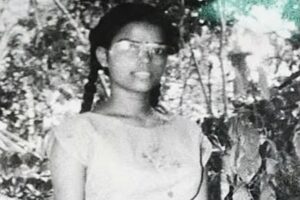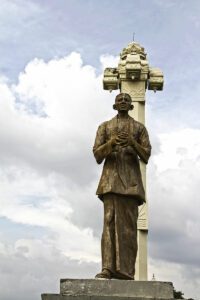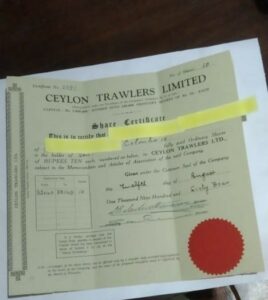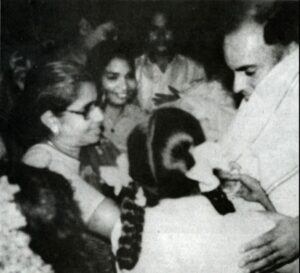Rajaratnam, a votary of militant politics, joined some 40 Tamils in forming Puli Padai (Tiger Force). After Dhanu killed Rajiv and died in the process, Prabhakaran gave a posthumous award to Rajaratnam for his contribution to the Tamil cause.

LTTE suicide bomber Dhanu (second from left) just before the Rajiv Gandhi assassination
His daughter Dhanu may have most grotesquely blown up Rajiv Gandhi, but A Rajaratnam was an admirer of Jawaharlal Nehru and turned emotional when he saw the veteran Indian leader in Sri Lanka, according to new details emerging in the wake of the Supreme Court move to free those jailed for the 1991 assassination of the former prime minister.
Nehru and Mahatma Gandhi were for decades highly revered figures among Sri Lanka’s Tamil community. It was very common to see framed photographs of the two leaders in Tamil homes in the island’s north and east in particular.
Rajaratnam became very eager to see Nehru in person when it became known that he would address students in the University of Ceylon’s Colombo campus.
“He was very fond of Nehru,” recalled a Sri Lankan Tamil who went with Rajaratnam to the university. “When he glimpsed Nehru, Rajaratnam was emotionally moved. So was I. Tamils saw Nehru as their own leader.”
But the moderation that Nehru believed in did not exist in Sri Lanka, as far as the widening gulf between the majority Sinhalese community and the minority Tamils was concerned.
Rajaratnam was one of the many Tamils who became disenchanted with the inability of Sinhalese-dominated governments to accommodate Tamil interests.
Over time, the government employee became a supporter of the Federal Party, which articulated Tamil demands, and later became a votary of militant politics. Dhanu, Rajaratnam’s eldest daughter from his second marriage, would emulate him.

Dhanu was Rajaratnam’s eldest daughter from his second marriage (Supplied)
This is how Rajaratnam joined some 40 Tamils in forming Puli Padai (Tiger Force), a secretive Tamil group that mainly drew government employees at various levels who were convinced that Tamils needed to chart their own future. Until now, nothing much has been known about the outfit, almost all of whose members are now dead.
Puli Padai was formed on 12 August 1960 after Rajaratnam and others took an oath at the ancient Koneswaram temple in Trincomalee.
The group, divided into four divisions, did not want any truck with mainstream politics. Its philosophy was to serve the Tamil people. It was for an armed struggle against Sinhala majoritarianism. The Sinhalese, it argued, would never respect a Gandhian struggle.

A statue of SJV Chelvanayakam from Jaffna, Sri Lanka (Wikimedia Commons/Mahinathan)
Puli Padai never spelt out its ultimate goal. Its members felt that the final choice should be left to the Tamil people — whether they wanted federalism or separation.
But despite its belief in militancy, Puli Padai accepted, ironically, SJV Chelvanayakam, who was known as Ceylon’s Mahatma Gandhi and who was a strong votary of non-violence, as its political leader. But Chelvanayakam was not a member.
Around 1963, Puli Padai bought a fishing trawler from Sri Lanka with money from supporters.
A South African captain came along to train its members in navigation. One member gave others lessons in astronomy to find directions in the sea. Yet another member formed the Ceylon Trawlers Limited in 1964 with a view that it will graduate into a Tamil navy one day.

A share certificate issued by Ceylon Trawlers Limited to a Tamil in 1964 (Supplied)
The first operation Puli Padai undertook was setting fire to the Jaffna Kachcheri (Secretariat) Lands Branch office in 1960. It was not a success as the mother-in-law of the government agent (collector) quickly called the fire service.
The idea was to destroy the land registers so as to have an open license for “Indian Tamils” in the tea-growing upcountry to settle and get land deeds in Sri Lanka’s north. The police never found out who was behind the arson.
After the Tamils launched a satyagraha campaign in Tamil areas in February 1961, hundreds were arrested. Most were interned in an army camp at Panagoda. Rajaratnam visited the inmates every Saturday afternoon, at times carrying messages to the leadership.
Puli Padai set up a Manavar Manaram, a student group with branches in the University of Ceylon (Peradeniya campus), Trincomalee, and Jaffna. This was to be a recruiting base. This outfit came much before the Federal Party set up the Manavar Peravai, many of whose members later embraced Tamil militancy.
Rajaratnam’s first wife died during childbirth — around 1962. He had a son from his first marriage. When his wife passed away, Rajaratnam was visiting the tea estates with Chelvanayakam. The latter immediately offered his car to Rajaratnam so that he could drive to Chavakachcheri in Jaffna for the funeral.
He married again. Rajaratnam’s eldest daughter from the second marriage was Kalaivani, also known as Thenmozhi or Dhanu.
Gradually, the Puli Padai withered away. It also split into two: Those who continued to regard Chelvanayakam as their leader and those who did not want to. Rajaratnam belonged to the former group.
Meanwhile, militancy took, first slowly and then rapidly, roots in Sri Lanka’s Tamil areas. As the CID began keeping a tab on Rajaratnam among many others, he shifted to India.
This was when young Tamil militants began to take shelter in Tamil Nadu to escape the police heat in Sri Lanka.

Rajiv Gandhi just moments before he was assassinated. The head of the suicide bomber Dhanu can be seen
Rajaratnam began suffering from asthma in the 1970s but managed to get the story of Puli Padai across to the militants, including Velupillai Prabahakaran, who first formed the Tamil New Tigers (TNT) and later the Liberation Tigers of Tamil Eelam (LTTE).
Rajaratnam may not have realised that Prabhakaran would one day turn his daughter Dhanu into a deadly — and historic — suicide bomber.
He died in Tamil Nadu — in 1975 or 1976. When Rajaratnam’s body was flown to Sri Lanka, Tamil leaders M Sivasithamparam and SC Chandrahasan, son of Chelvanayakam, were at the Katunayake airport to receive it. The body was taken to Jaffna for last rites.
As Tamil militancy galloped, Dhanu joined the LTTE.
After Dhanu killed Rajiv Gandhi and died in the process, Prabhakaran gave a posthumous award to Rajaratnam for his contribution to the Tamil cause. The link between the father (who adored Nehru) and the daughter (who killed Nehru’s grandson) was not lost on anyone. But for Dhanu, Rajaratnam may have remained an obscure figure in Tamil politics.
(MR Narayan Swamy is a freelance journalist in New Delhi. He began his career more than four decades ago. He had a long innings in UNI, AFP, and IANS. His focus areas are diplomacy, politics, and spirituality, and he loves to read and review books. He is the author of three books on the Sri Lankan conflict)

Jun 06, 2024

May 16, 2024

May 15, 2024

May 15, 2024

May 14, 2024

Mar 01, 2024